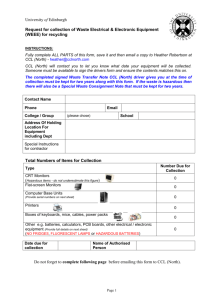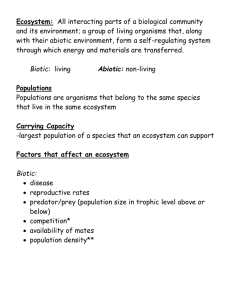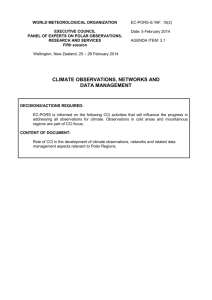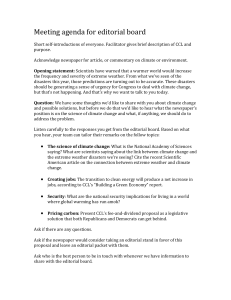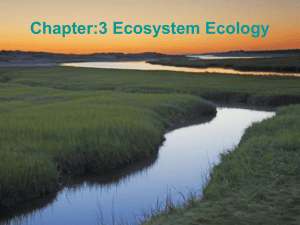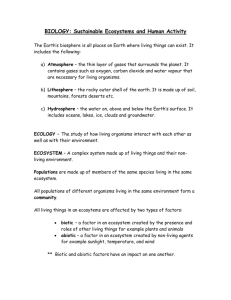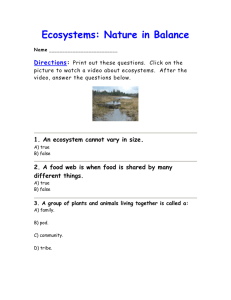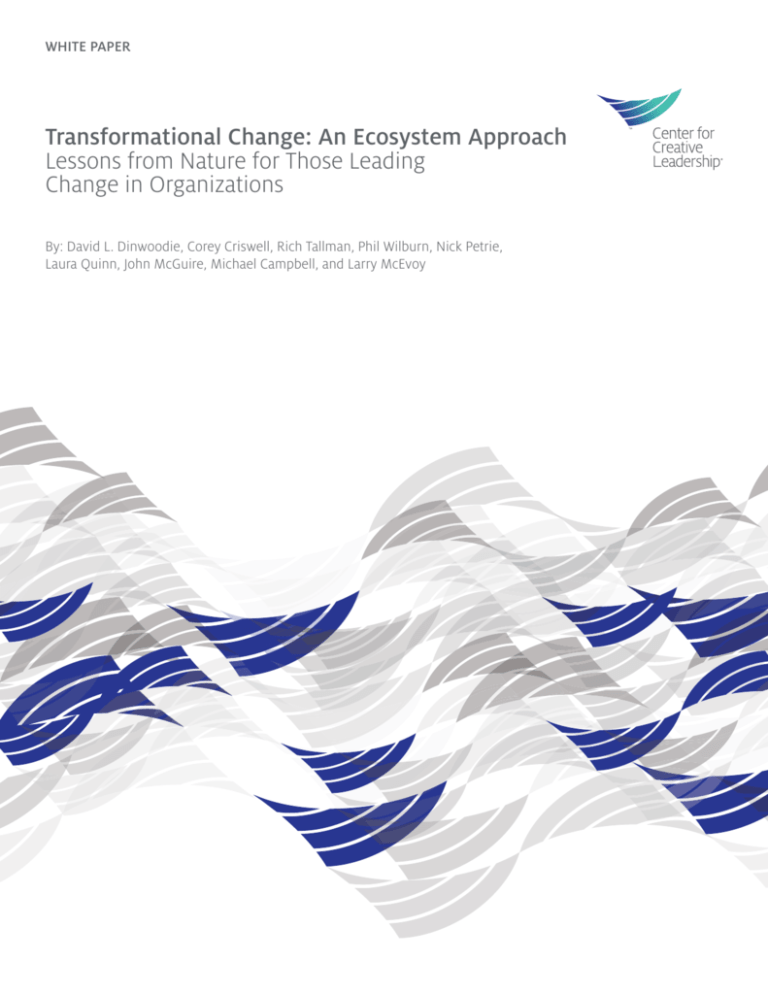
WHITE PAPER
Transformational Change: An Ecosystem Approach
Lessons from Nature for Those Leading
Change in Organizations
By: David L. Dinwoodie, Corey Criswell, Rich Tallman, Phil Wilburn, Nick Petrie,
Laura Quinn, John McGuire, Michael Campbell, and Larry McEvoy
Contents
Transformational Change Is Widespread, Dominant, and Self-Sustaining
1
Transformational Change Flows in Predictable Stages
4
Transformational Change Occurs across Communities Facing Systemic Disturbances
6
Change Agents Interact through a Process of Natural Succession
8
Change Agents Interact through Informal Webs of Influence
10
Transformational Change Encounters Predictable Enhancers and Inhibitors 12
Bibliography16
About the Authors
17
Transformational Change Is Widespread,
Dominant, and Self-Sustaining
What if our organizational change agents interacted
like the players in natural ecosystems so that transformational change was truly widespread, dominant,
and self-sustaining?
Change in the natural world occurs similarly to the
way change occurs within our organizations. The
problem is we don’t always recognize the similarities.
In the natural world, change is a constant process of
evolutionary and revolutionary shifts resulting from
the interaction of ecosystem players, change agents,
as they deal with disturbances across the system.
Disturbances to the ecosystem are myriad and spark
changes that take root, overcome barriers, and
prosper, or shrivel and die depending on the adaptive
ability of the change agents.
Changes that prosper and, over time, transform the
ecosystem tend to be those that span the boundaries
between an intricate web of communities and species, overcome natural barriers, and pass the ultimate
test of “survival of the most adaptable.”
Transformational change to the ecosystem is often
triggered by an initial disturbance and, as the impact
of that change cascades throughout the interconnected ecosystem communities, the knock-on effects
take root in unexpected ways. Both the predictable
and unpredictable impact of change tends toward
balance, sustainability, stability, and resiliency of the
whole system. A revolutionary change here leads
to an evolutionary change there and, as seemingly
isolated shifts gain momentum across the system,
the entire habitat undergoes a fundamental transformation that ultimately becomes self-sustaining.
Once it takes root, the underlying transformational
change goes beyond any of the distinct communities, species, or individual players that interact across
the system. In organizations, this occurs when a shift
happens in an industry that requires the organization to make rapid adjustments to its business model,
strategy, structure, or leadership.
“It is not the strongest of the species that survives,
nor the most intelligent that survives. It is the one
that is most adaptable to change.”
—Charles Darwin
©2014 Center for Creative Leadership. All rights reserved.
1
Consider the classic example of the reintroduction
of wolves in Yellowstone National Park.
Two initial systemic disturbances—the eradication of
wolves and the prohibition of hunting in the park—resulted
in unnaturally large herds of elk for the size of the local
ecosystem. This led to massive overgrazing of new-growth
vegetation and the destruction of tree species throughout
the park, serious problems that required a solution. The
solution to the elk problem was to create a new systemic
disturbance by reintroducing the natural predator of the
elk—the wolf.
As expected:
• The elk colony decreased to balanced levels.
• Vegetation increased and trees grew to taller
levels.
The unanticipated cascade effect across ecosystem
communities:
• Increased vegetation and growing forests turned
previously bare valleys into lush habitats.
• As the wolf population grew, the coyote population shrank to more balanced levels.
• With lush habitats and a shrinking coyote colony,
the mouse, weasel, rabbit, fox, hawk, eagle,
raven, bear, and beaver communities flourished.
• As the beaver colony flourished, niche communities were created to support other river species.
2
©2014 Center for Creative Leadership. All rights reserved.
What impact did the reintroduction of 14 grey wolves in
1995 have on the Yellowstone National Park ecosystem?
The broad systemic impact was unexpected, widespread,
dominant, and ultimately self-sustaining.
• As river habitats consolidated, the flow of the
river was altered and brought nutrients to communities throughout the ecosystem.
• As the ecosystem became richer, the wolf colony
prospered.
• As the wolf colony grew, “wolf-watching tourism”
increased bringing an estimated $5 million per
annum to help finance the ongoing sustainability
of Yellowstone National Park.
• And the elk? Ultimately their behavior changed
as well in grazing/foraging, herding behavior,
and survival tactics. Their numbers significantly
dropped then stabilized to levels sustainable for
the ecosystem.
The introduction of a top predator, or “eco-change
leader,” aimed at solving a concrete problem actually brought observable behavioral change that
cascaded down and around the interconnected ecosystem players and resulted in a long-term systemic
transformation. Systemic change in both nature
and the organization is often characterized by a
series of simultaneous “outside-in” and “inside-out”
activities, undertaken by change leaders across the
change terrain.
Outside-in activities represent the tasks of preparing and introducing systemic disturbances and
creating the systems, structures, and processes to
guide change efforts. The planned reintroduction
of the wolf to Yellowstone National Park in order to
solve a specific problem was an outside-in activity.
Inside-out capabilities are reflected in the change
leader’s ability to create a web of interdependent
change agents and shape an environment that
elicits the behaviors across the system necessary for
transformational change to take root and flourish–
the type of dynamic interaction we observed across
the wolf, elk, coyote, mouse, weasel, rabbit, fox,
hawk, eagle, raven, bear, and beaver communities
that brought widespread, dominant and self-sustaining change to the ecosystem. In the organization,
we would associate the outside-in activities with the
management tasks related to change and the insideout activities with leading the human element of
change processes, two integral and inseparable factors of success.
©2014 Center for Creative Leadership. All rights reserved.
3
Transformational Change
Flows in Predictable Stages
What if our organizational change leaders guided transformation efforts through
stages so that the right change flourished across the system?
One common thread across the wide body of eco-change literature is the staged
approach to systemic transformation in which change agents are preparing,
nourishing, spreading, and disseminating change throughout the ecosystem. The
number of stages and terminology attached to the distinct stages may vary from
model to model, but the process flow tends to be common. The model below
synthesizes the stages of change and depicts how change may flow through our
organizations as we attempt to drive systemic transformation.
Stages of Transformational Change
Systemic
Transformation
4
©2014 Center for Creative Leadership. All rights reserved.
In Stage 1, the change process is initiated by gaining a deep understanding of the terrain
and preparing the early change adopters to support change:
What communities or stakeholder groups need to be taken into consideration? Who are the
players and how do they interact? How are they connected, and what would an effective
change agent network look like? How might the players influence or be influenced by others?
In Stage 2, the seeds of change are sown and the focus is on building and nourishing the
relationships across change agents so that the transformational foundations take root.
Here, the early change adopters begin to hand off to pragmatists in the transformation
process, some change initiatives die and others continue to flourish.
In Stage 3, dominant changes begin to spread across the terrain and adapt to the ecosystem inhibitors that are encountered. Here the survival of the most adaptable is the driving
principle, and change leaders must be tenacious in their efforts to overcome barriers to
keep others onboard.
In Stage 4, change pragmatists are handing off to mature players specialized in disseminating the ecosystem changes that will become self-sustaining over time.
Of course, by the time the dominant changes are
spread system-wide and gain a life independent of
any particular change agent in the habitat, the early
adopters have reinitiated the change process and
new transformation efforts are starting to circulate
across the network of interconnected change agents.
Change that ripples throughout the system often
creates anxiety for those within it. Questions arise
about whether the new environment will support
each group and whose power and rewards will
increase or decline as a result. For humans, as well
as animals, any potential threat can lead to a state
of fight or flight. This is helpful in the moment as it
gives the individual the energy to survive. The difference with animals is that once the threat subsides,
the animal will come back down to its resting state.
Humans are different in that they can continue ruminating on and on after the event about ”what ifs” or
about the future and all the changes that could negatively impact them. Therefore, one of the skills of the
effective change agent is to be able to anticipate and
adapt to a changing environment without adding in
negative rumination about things that are outside of
its control.
©2014 Center for Creative Leadership. All rights reserved.
5
Transformational Change Occurs across
Communities Facing Systemic Disturbances
What if our organizational change leaders could
predict the impact of systemic disturbances so that
change ultimately benefited the entire system?
Similar to organizations, ecosystems have distinct
stakeholder groups or communities that operate according to their own priorities, interests, resources,
and limitations. These communities coexist, interact,
and jointly contribute to the overall success or failure of the broader system. There is a natural order of
interaction across species and structures that,
to a certain extent, govern the relationships between
the players. We see this in organizations as structures, hierarchies, policies, procedures, systems, and
culture coalesce to dictate the way people interact
and get things done.
Significant change to the system tends to come
through events that disturb the current state, shake
things up, and oblige the stakeholders to modify
their behavior.
Ecosystem Communities Facing Disturbances
As early American ecologist Frank Egler once stated,
“Ecosystems are more complicated than we think,
they may be more complicated than we can think.”
6
©2014 Center for Creative Leadership. All rights reserved.
As we saw with the wolves of Yellowstone National Park, the behavior modification has far-reaching
ripple effects. The initial system disturbance of
removing the wolves from the ecosystem had
unforeseen negative consequences, while the
reintroduction of the wolves brought about many
unexpected benefits.
Some communities are closely linked and directly
feel and impact the changes of other groups.
Other communities are loosely linked and the
impact is experienced indirectly. The ability to
map the eco-change terrain, understand the
relationships between species, and predict the
potential impact on the different players in the
system is indispensable to introducing transformational change in a coherent, sustainable way—in a
way that both changes and brings stability to the
whole. In the organization, it is equally important
for change leaders to map the terrain of stakeholder groups, change agents, relational ties,
and avenues of influence in order to predict how
change disturbances will reverberate across the
system.
According to some ecologists, diversity of species
and the interaction across the diverse species in
the ecosystem is the key to maintaining overall
stability. This dynamic interaction is at times a
catalyst for transformation while in other circumstances, it can dampen the potential to drive
change. Increased diversity brings greater complexity (i.e. difficulty) to predicting the cross-species relationships while simultaneously increasing
the potential for change to be widespread and
self-sustaining, if and when it takes root.
©2014 Center for Creative Leadership. All rights reserved.
7
Change Agents Interact through
a Process of Natural Succession
What if our organizational change leaders
were adept at guiding change so that it flowed
naturally through the system?
When a system disruption significantly impacts
the ecosystem, the different players or change
agents react and interact in different ways.
There tends to be a natural succession of how
change flows throughout the ecosystem and
how different types of change agents enhance
or inhibit change initiatives along the way. For
example, in both nature and organizations,
we generally see interactions among three
types of change adopters: pioneers, midfielders and mature players. Let’s run through
an example of a “primary succession” process
where change starts from a completely clean
slate and consider the roles that the different
change agents play.
8
©2014 Center for Creative Leadership. All rights reserved.
The pioneers can be seen as generalists that are
extremely opportunistic and able to quickly assimilate
changes to their habitat. While the pioneers are quick
to adopt opportunistic change and ensure that it is
widespread, they are not good at competition. They
tend to get pushed to the periphery and many of their
change efforts fail if they are not effectively converted
into initiatives that can be readily assimilated by midfield players.
The mature players can be seen as specialists that
are adept at selectively capturing new resources and
pushing out other players. They are good at competition and ensuring that the most impactful changes are
self-sustaining and endure over time. While the mature
players help institutionalize change throughout different parts of the ecosystem, they can bring systemic
stagnation if the pioneers and mid-fielders are not able
to effectively play their roles.
The mid-fielders can be seen as the pragmatic filter
between the rapid-prototyping pioneers and the more
selective species in the ecosystem. Mid-fielders help
translate change quantity into change quality as they
weed out changes that do not necessarily benefit the
broader habitat. They help establish the dominance of
change initiatives that benefit the broader system.
Of course, there are situations in which change agents
may adapt their roles in accordance with factors that
impact the change process; however, it is the dynamic
interaction across and between these players that we
must appreciate if we are to guide efforts so change
flows naturally through our organizations.
©2014 Center for Creative Leadership. All rights reserved.
9
Change Agents Interact through
Informal Webs of Influence
What if our organizational change leaders built relationships between
the people who really get things done so that transformation gained
momentum across the system?
Transformational change that is ultimately widespread, dominant, and
self-sustaining tends to come to fruition when there is energy flow and
influence exercised across players at different levels and different parts
of the system. In nature, change cascades up, down, and around the ecosystem as the agents of change build relationships and interact in ways
that fall outside of the established norms. Research shows that in the
organization, a similar process tends to unfold as change gains momentum outside of the formal hierarchy and change leaders exert influence
across traditional organizational boundaries. As depicted in the graph
below, effective change agent webs or networks evolve over time to support transformation.
Change Agent Networks Evolve to Support Transformation
Source: Adapted from Krebs & Holley (2006)
10
©2014 Center for Creative Leadership. All rights reserved.
The ability of change leaders to forge relationships across stakeholder boundaries and influence change
agents to evolve from fragmented webs to transformational webs is critical to achieving self-sustaining
change that transforms the ecosystem.
Fragmented Webs: players interact primarily with species
within their distinct stakeholder group
to
Centralized Webs: primary colony of change agents is
central to pushing widespread change process
to
Multi-clustered Webs: select stakeholder groups are
interacting with each other to find equilibrium and
discover strategies to drive dominant change
to
Transformational Webs: change is solidly rooted
and flowing system-wide
©2014 Center for Creative Leadership. All rights reserved.
11
Transformational Change Encounters
Predictable Enhancers and Inhibitors
What if our organizational change leaders
learned from both failure and success so that our
transformation processes lead to superior performance over time?
Failure is common in transformation processes
as rapid-prototype changes instigated by the
pioneers pass the filters of the mid-fielders and
ultimately mature players selectively propagate
system-wide change. At each stage in the transformation process, there are elements that will
predictably enhance certain changes and inhibit
others.
Let’s go back to the reintroduction of the wolves
in Yellowstone National Park. What factors enhanced survival of this ecosystem change? Obviously, the overpopulation of elk in the habitat and
the degraded forests enhanced the ability of the
wolves to hunt and nourish the pack members.
As the ecosystem evolved, forests attracted new
species and provided better living conditions and
river communities added greater diversity to the
habitat; the wolf continued to prosper.
12
©2014 Center for Creative Leadership. All rights reserved.
At the same time, there were important ecosystem inhibitors for the wolves to overcome. Ranchers in the region were against the reintroduction
of wolves due to fear of losing their livestock. The
wolf community had to adapt to poachers, traps,
and poisons aimed at filtering out this systemic
disturbance before it had a chance to establish a
permanent niche in the ecosystem.
The ability of change leaders to foresee the predictable enhancers and/or inhibitors that impact
the success or failure of change initiatives is critical to zealously driving systemic transformation.
True change leaders are tenacious and adaptable
enough to overcome impediments to organizational change.
©2014 Center for Creative Leadership. All rights reserved.
13
Systemic Change in Our Organizations
So, what lessons can we take from the examples of transformational change in the natural world that are
applicable to change efforts in the organizations in which we lead?
Below is a summary of tips for change leaders as they promote the change initiatives that are so critical to
the short-term profitability and long-term sustainability of our organizations:
• Align change disturbances with organizational guiding principles. How do our change
initiatives support the over-arching vision,
mission, priorities, and strategies that will
bring prosperity across the organizational
ecosystem? Do the change disturbances support strategy execution and really help drive us
toward our desired future?
• Map the change terrain. Do we truly appreciate the interconnection of the stakeholder groups and change agents within those
groups? Do we account for their aims, aspirations, motivations, desires, limitations, etc.?
• Know the players and where they stand. Do
we fully understand the extent to which the
agents needed to drive our change will act as
enhancers or inhibitors? To what extent? Why?
Why not? What if?
• Build the right relationships. Are we investing the time, energy, and effort necessary to
sustain the relationships across change agents
in order to move our transformation initiatives
forward? Do our agents help cascade change
up, down, and around the organizational ecosystem? Do we build, energize, and leverage
powerful informal webs of influence.
• Nurture enhancers and overcome inhibitors.
Are we effectively persuading change agents to
get onboard and drive the necessary changes
in their parts of the organization to ensure that
transformation truly takes root and flourishes?
Do we nourish those that support us? Do
we endure in the face of resistance? Do we
convert others to our cause? Do we strengthen
others’ resolve?
• Be a zealous change leader. Are we passionate about the change we lead? Do we provide
direction to our change agents? Alignment?
Commitment? Do we identify the what, when,
where, how, why of building the necessary
relationships across the organization to drive
change? Do we follow through? Do we review
what people do? Do we make it matter? Are
we examples of the change we expect to see in
others?
• Adapt, adapt, adapt to survive. Are we sufficiently attentive to systematic disturbances
that may derail our change efforts? Do we
consider the knock-on effects? Are we flexible
enough to shift our plans? Are we resilient
enough to deal with controversy? Are we elastic enough to stretch without snapping?
Organizations that are superior performers over time develop the individual and organizational capability to
invent, reinvent, and transform their business models according to the dynamic nature of the ecosystems in
which they operate.
Leaders in these organizations identify the stakeholder groups that are crucial to driving change, build and
nurture the critical change agent relationships across the organization, overcome inhibitors inherent to their
organizational ecosystems, step up as living examples of leading change, and develop the adaptability necessary to drive widespread, dominant, self-sustaining change.
14
©2014 Center for Creative Leadership. All rights reserved.
©2014 Center for Creative Leadership. All rights reserved.
15
References
Battilana, J., & Casciaro, T. (2013). The network secrets of great change agents. Harvard Business Review,
91(7), 62-68.
Blackburn T.M., Pyšek P., Bacher S., Carlton J.T., Duncan R.P., Jarošík V., Wilson J.R.U. & Richardson D.M.
(2011). A proposed unified framework for biological invasions. Trends in Ecology & Evolution 26, 333–339.
Di Castri, F. (1989). Biological Invasions: A Global Perspective. New York, NY: John Wiley & Sons.
Farquhar, B. (2011). Gray wolves increase tourism in Yellowstone National Park. Yellowstone Journal and
YellowstonePark.com. Retrieved from http://www.yellowstonepark.com/2011/06/gray-wolves-increasetourism-in-yellowstone-national-park/
Krebs, V., & Holley, J. (2006). Building smart communities through network weaving. Appalachian Center for Economic Networks. Retrieved from www.acenetworks.org
Loewe, L. (2009). A framework for evolutionary systems biology. BMC Systems Biology.
McGuire, J.B., & Rhodes, G. (2009). Transforming Your Leadership Culture. San Francisco, CA: Jossey-Bass.
Pasmore, W.A. (2011), Tipping the balance: Overcoming persistent problems in organizational change,
in Abraham B. (Rami) Shani, Richard W. Woodman, William A. Pasmore (ed.) Research in Organizational
Change and Development (Research in Organizational Change and Development, Volume 19), Emerald
Group Publishing Limited, pp.259-292
Petrie, N. (2013). Wake up: The surprising truth about what causes stress and how leaders build resilience. (White Paper). Greensboro, NC: Center for Creative Leadership.
Qamar, B., & Ali, Q. (2012). Towards a hybrid model of strategic change: Combining revolutionary and
evolutionary approaches. International Journal of Management and Strategy, 1–9.
Robbins, J. (2004). Lessons from the WOLF. Scientific American, 290(6), 76–81.
Shea, K., & Chesson, P. (2002). Community ecology theory as a framework for biological invasions.
Trends in Ecology & Evolution, 17, 170–176.
Willburn, P., Cullen, K. (2012) A leader’s network: How to help your talent invest in the right relationships at the right time (White Paper). Greensboro, NC: Center for Creative Leadership.
Van der Velde, G., et al. (2006). Biological invasions: Concepts to understand and predict a global
threat. Ecological Studies, 61–89.
All photos courtesy of the National Park Service
16
©2014 Center for Creative Leadership. All rights reserved.
About the Authors
Dr. David L. Dinwoodie Dr. David L. Dinwoodie is the Center for
Creative Leadership’s (CCL®) Global Director, Individual and Team
Leadership Solutions, a role in which he is responsible for CCL’s global
portfolio of programs, products and services in the Open-Enrollment,
Custom, Coaching and Assessment Services lines of business. He is
a coauthor of Becoming a Strategic Leader: Your Role in Your Organization’s Enduring Success, and a research associate on the Leadership Across Differences project. He holds a master of Interna­tional
Management from the Thunderbird School of Global Manage­ment
and earned an MBA from ESADE Business School in Barcelona. His
doctoral degree is from Aston University (UK) in the area of organizational and workgroup psychology. Before joining CCL, he held management positions with pan-European and global responsibilities in
Ernst & Young, BICC General Cable, Planeta de Agostini, Bristol-My­ers
Squibb, and EADA Business School. He also taught courses in strategic
management, change management and leadership development at
institutions such as ESADE Business School (Spain), EADA Business
School (Spain), Centrum Business School (Peru) and Universidad de
Rosario (Colombia).
Corey Criswell is a faculty member at CCL in Colorado Springs, CO,
engaged in both facilitation and research. Corey’s work has focused
on such topics as executive presence, vision, lessons of experience,
and the challenges of senior executive leadership. She earned a BA
in biology from the University of Colorado in Boulder and a master’s
degree in ecology from the Florida Institute of Technology. Corey
has authored a variety of industry press and peer-reviewed journal
articles that appeared in Chief Learning Officer, Leadership Excellence,
Leadership Review, and HR Executive. She coauthored the guidebooks
Building an Authentic Leadership Image and Creating a Vision. She has
coauthored multiple white papers including Grooming Top Leaders:
Cultural Perspectives from China, India, Singapore, and the United
States, and 10 Trends: A Study of Senior Executives’ Views on the
Future.
Rich Tallman is a CCL Senior Enterprise Associate in Colorado
Springs, CO. He trains multiple open-enrollment programs and works
with many of the Center’s custom clients, designing and delivering
programs tailored to their specific needs. In addition, he is a certified
feedback specialist having served on the adjunct faculty for six years.
Prior to joining the Center, Rich had a consulting practice in organization design and development. During his 20 years, he worked with
a variety of organizations undergoing substantive change such as
restructuring, mergers, and change initiatives to increase productivity
and profitability. These clients have included organizations from the
public and private sectors as well as profit and not-for-profit, with
industries ranging from telecommunications to healthcare to manufacturing and finance.
Phil Wilburn is a CCL faculty member and social network analysis
expert. He has mapped and analyzed organizational and social networks for government and private sector clients since 2005. Based in
Colorado Springs, Phil also teaches in the Leadership Development
Program (LDP)® and various custom programs. Most recently, he
taught social network analysis to intelligence community members
looking to better understand terrorist networks.
Nick Petrie is a senior faculty member at CCL in Colorado Springs,
CO, where he facilitates customized programs for senior-level
executives and writes extensively about future trends in leadership
development. His current focus is working with CEOs and their teams
to transform organizational cultures. A New Zealander with significant
international experience, Nick has worked and lived in Asia, Europe,
Britain, Scandinavia, and the Middle East. Industries in which he has
worked include government, law, accounting, engineering, construction, and telecommunications. He holds a master’s degree from Harvard University in learning and teaching. He also holds undergraduate
degrees from New Zealand’s Otago University.
Laura Quinn, PhD, is the Global Director of Organizational Leadership Solutions, managing CCL’s work in strategy development
and execution, talent sustainability, organizational and leadership
culture, organizational change, transformation, and executive team
leadership. A certified feedback coach, Laura also trains in several
CCL programs. She has made numerous conference presentations
on her work and has published in CCL’s Leadership in Action, Business
Communication Quarterly, and the Journal of Management Communication. Prior to joining CCL, Laura was a professor in the University of
Colorado’s communication department, and worked for seven years
in the high-tech industry, holding management positions in finance
and materials. She has a BA in business and an MA in communication
from the University of Colorado. Her PhD is in organizational communication from the University of Texas at Austin.
John B. McGuire is a Senior Fellow and transformation practice leader at CCL, specializing in Leadership for an Interdependent World. He
is an international authority on leadership culture and organizational
transformation, and a practitioner, author, speaker, and researcher.
In his current role, he combines action research in partnership with
client organizations, while developing portfolio services and tools.
His practical-experience approach has led to advancing methods that
increase the probability of success in organizational change. John
has helped organizations in the healthcare, manufacturing, service,
government, and nonprofit sectors. He holds masters degrees from
Harvard and Brandeis Universities, and has received various excellence awards for his contributions in both the private and public sectors. He is author of Transforming Your Leadership Culture, published by
Jossey-Bass.
Michael Campbell engages in both facilitation and research at
CCL, with his work focused on such topics as talent management,
succession management, high-potential leaders, as well as senior
executive leadership. He is cocreator of CCL’s Talent Sustainability
Framework as well as the CCL assessment tool Talent Orchestrator.
Through research, design, and facilitation, Michael has worked with
and supported clients representing manufacturing, retail, and professional services organizations. He has designed and trained workshops
on coaching effectiveness, executive selection, and vision. Michael
has conducted several webinars for CCL’s Leading Effectively Webinar
Series, and has codesigned experiential modules, tools, and activities
for CCL programs.
Larry McEvoy, MD, a seasoned healthcare executive and experienced
emergency physician, has the unique capacity to facilitate different
strategic and professional perspectives toward collaborative innovation and value. Particularly focused on the shared work between
executives, clinicians, and clinical leaders, Larry’s experience as both
a CEO and a clinician deepen his skill in facilitating dynamic shifts
in mindset, culture, and performance. Whether he is working as a
titular leader, consultant, facilitator, or storyteller, Larry is particularly
effective at creating strategic alignment, inclusive leadership, and
energetic collaboration in service to high performance.
©2014 Center for Creative Leadership. All rights reserved.
17
The Center for Creative Leadership (CCL®) is a top-ranked,
global provider of leadership development. By leveraging
the power of leadership to drive results that matter most
to clients, CCL transforms individual leaders, teams,
organizations and society. Our array of cutting-edge
solutions is steeped in extensive research and experience
gained from working with hundreds of thousands of
leaders at all levels. Ranked among the world’s Top 5
providers of executive education by the Financial Times
and in the Top 10 by Bloomberg BusinessWeek, CCL has
offices in Greensboro, NC; Colorado Springs, CO; San
Diego, CA; Brussels, Belgium; Moscow, Russia; Addis
Ababa, Ethiopia; Johannesburg, South Africa; Singapore;
Gurgaon, India; and Shanghai, China.
CCL - Americas
www.ccl.org
+1 800 780 1031 (U.S. or Canada)
+1 336 545 2810 (Worldwide)
info@ccl.org
Greensboro, North Carolina
+1 336 545 2810
Colorado Springs, Colorado
+1 719 633 3891
San Diego, California
+1 858 638 8000
CCL - Europe, Middle East, Africa
www.ccl.org/emea
CCL - Asia Pacific
www.ccl.org/apac
Brussels, Belgium
+32 (0) 2 679 09 10
ccl.emea@ccl.org
Singapore
+65 6854 6000
ccl.apac@ccl.org
Addis Ababa, Ethiopia
+251 118 957086
LBB.Africa@ccl.org
Gurgaon, India
+91 124 676 9200
cclindia@ccl.org
Johannesburg, South Africa
+27 (11) 783 4963
southafrica.office@ccl.org
Shanghai, China
+86 21 5168 8002, ext. 801
ccl.china@ccl.org
Moscow, Russia
+7 495 662 31 39
ccl.cis@ccl.org
Affiliate Locations: Seattle, Washington • Seoul, Korea • College Park, Maryland • Ottawa, Ontario, Canada
Ft. Belvoir, Virginia • Kettering, Ohio • Huntsville, Alabama • San Diego, California • St. Petersburg, Florida
Peoria, Illinois • Omaha, Nebraska • Minato-ku, Tokyo, Japan • Mt. Eliza, Victoria, Australia
Center for Creative Leadership® and CCL® are registered trademarks owned by the Center for Creative Leadership.
©2014 Center for Creative Leadership. All rights reserved.
8.14

